
Organic Chemistry: Definition, Types, Examples and Basic Principles
Organic chemistry is a big and changing field that looks at carbon-based compounds in nature and labs. It covers the structure, properties, and changes of these complex molecules. These molecules are key to life and important for many industries.
It ranges from simple hydrocarbons that power our world to complex biomolecules that keep our bodies going. Organic chemistry includes a wide variety of compounds and their complex reactions. By understanding how these carbon-based systems work, experts can make new discoveries and improve things like medicines and materials.
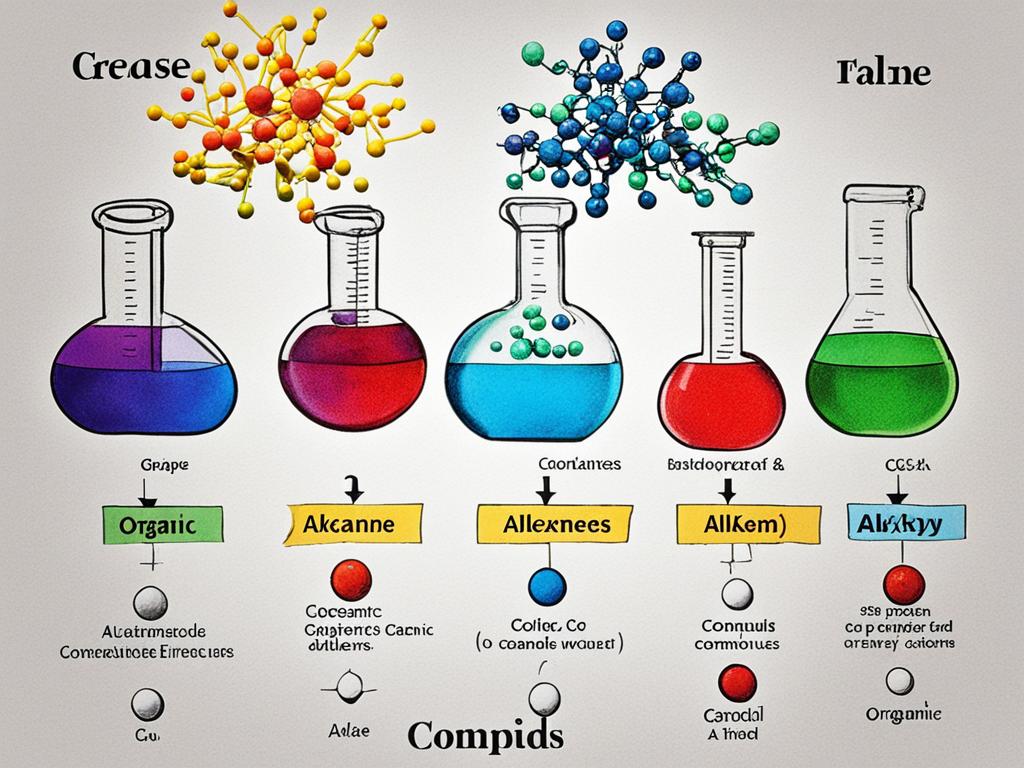
This article will deeply explore organic chemistry’s definition, types, examples, and basic principles. It will give readers a strong base in this key science. We’ll look at its history, importance, and uses to see how it affects our world.
What is Organic Chemistry?
It is all about studying compounds that have carbon in them. These compounds can be found in living things or made in labs. It covers everything from simple molecules to complex ones found in living beings.
Definition and Scope
It looks into the makeup and changes of organic compounds. These compounds mainly have carbon and hydrogen atoms, plus other elements like oxygen, nitrogen, sulfur, and halogens. They can form many functional groups and take part in different synthesis and reaction mechanisms.
Historical Development
The study of organic chemistry started in the late 1700s with the examination of compounds from living things. Over the years, it grew, thanks to new tools like spectroscopy. This helped scientists understand organic compounds better. Now, it is key in areas like pharmaceuticals, agrochemicals, materials science, and energy production.
| Key Milestones in the History of Organic Chemistry | Year |
|---|---|
| Identification of the first organic compound, acetic acid | 1760 |
| Establishment of the carbon-based nature of organic compounds | 1806 |
| Discovery of the benzene ring structure | 1865 |
| Development of the structural theory of organic chemistry | 1858-1869 |
| Invention of synthetic dyes and the rise of the chemical industry | 1856 |

Organic Chemistry: Importance and Applications
Organic chemistry is key to many areas of science. It’s used in various industries and everyday life. This field is vital for making important biomolecules, advancing materials science, and improving pharmaceuticals.
It is crucial for creating many compounds we need for health and the environment. It helps make pharmaceuticals and materials that are good for our planet. This makes it a vital tool for solving global problems.
In medicine, organic chemistry is key for finding and making new drugs and therapies. Chemists use their knowledge to make new biomolecules that fight diseases. This has led to new treatments and better health for people.
It also helps make advanced materials for many uses. It’s used in making strong plastics, fibers, and even new energy sources. This work is changing technology and the future of many industries.
The role of organic chemistry is huge. It touches industries, everyday life, and our quest for knowledge. It’s a key area that keeps expanding our view of the world.
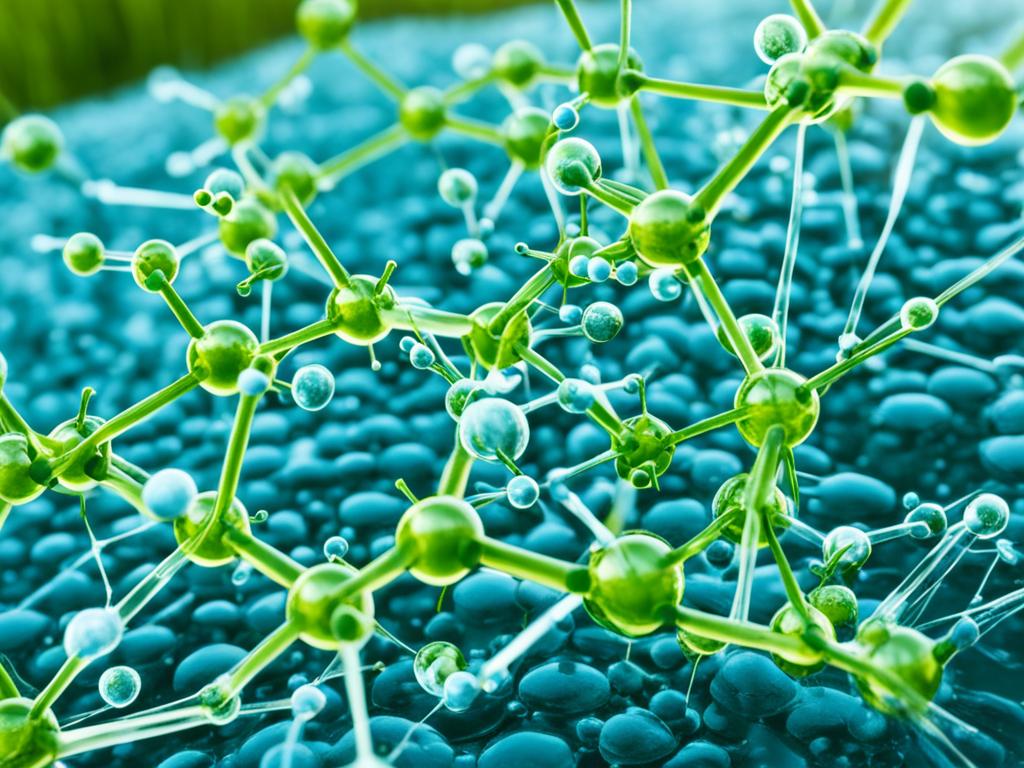
Types of Organic Compounds
It covers a wide range of compounds, each with its own structure and groups. These compounds fall into different classes, like alkanes, alkenes, alkynes, aromatics, alcohols, aldehydes, ketones, carboxylic acids, esters, ethers, and amines.
Functional Groups
Functional groups are key in organic chemistry. They decide how compounds react and what their properties are. For example, -OH in alcohols and -CHO in aldehydes define their chemical behavior.
Classes of Organic Compounds
Here are the main types of organic compounds:
- Alkanes are hydrocarbons with single bonds between carbon atoms. Examples include methane and ethane.
- Alkenes have at least one double bond between carbon atoms. They include ethene and propene.
- Alkynes have a triple bond between carbon atoms. Acetylene and propyne are examples.
- Aromatics are rings with double bonds, like benzene and toluene.
- Alcohols have a -OH group, found in methanol and ethanol.
- Aldehydes have a C=O group with a hydrogen atom, seen in formaldehyde and acetaldehyde.
- Ketones also have a C=O group but with two carbon atoms, like acetone and cyclohexanone.
- Carboxylic acids have a -COOH group, found in formic acid and acetic acid.
- Esters are made from a carboxylic acid and an alcohol, such as ethyl acetate and methyl benzoate.
- Ethers have an oxygen atom linking two groups, like diethyl ether and anisole.
- Amines have a nitrogen atom with hydrogen or alkyl/aryl groups, including methylamine and aniline.
Knowing about the structure and groups of these compounds helps us understand their properties and uses in science and industry.
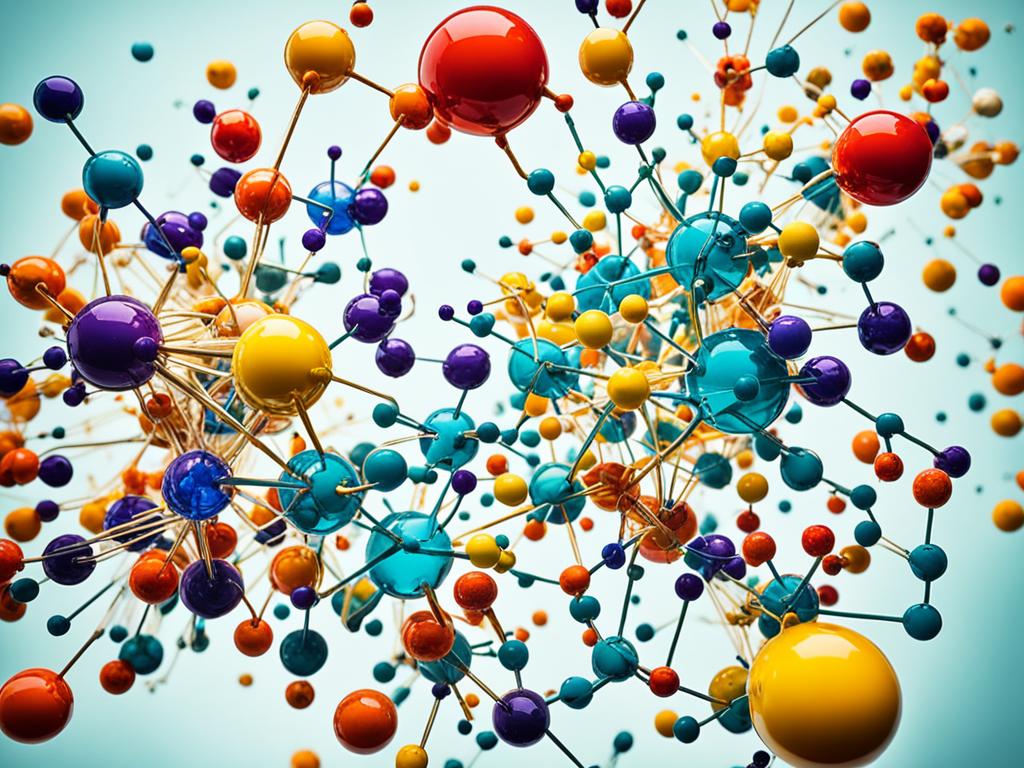
Basic Principles of Organic Chemistry
It is all about studying carbon-based compounds and how they work. It looks at their structure and how they react with each other. This field is built on key principles that explain how these complex molecules behave.
We’ll dive into the main ideas that shape organic chemistry. This includes how molecules bond, their structure, and what makes them change.
Bonding and Structure
Organic compounds are special because of their carbon-carbon and carbon-hydrogen bonds. These bonds form when electrons are shared. This sharing leads to a wide variety of molecules, from simple to complex.
Knowing about organic chemistry bonding helps us understand how different organic chemistry functional groups work.
Reaction Mechanisms
It is full of complex reaction mechanisms. These explain how one compound turns into another. They can be nucleophilic, electrophilic, or radical-based.
Learning these organic chemistry reaction mechanisms is key. It helps in making new compounds and predicting what happens in reactions.
| Concept | Description |
|---|---|
| Organic Chemistry Bonding | The unique properties of organic compounds stem from the versatile nature of carbon-carbon and carbon-hydrogen bonds, formed through the sharing of electrons. |
| Organic Chemistry Functional Groups | The presence and arrangement of specific functional groups in organic molecules determine their reactivity and physical properties. |
| Organic Chemistry Reaction Mechanisms | The transformation of one organic compound into another is governed by intricate reaction mechanisms, which can be classified as nucleophilic, electrophilic, or radical in nature. |
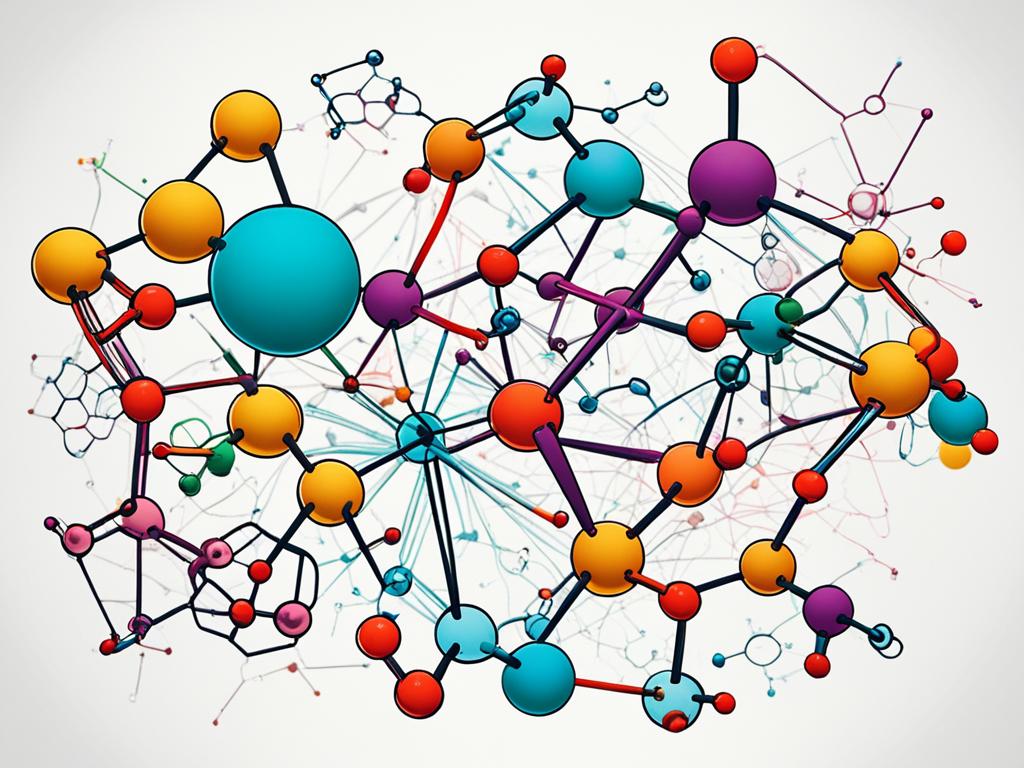
Organic Chemistry Techniques
In organic chemistry, scientists use many techniques to make, clean, and study organic compounds. These methods are key to understanding the structure, properties, and how organic substances react. This knowledge is vital for fields like medicine, materials science, and energy.
Organic Synthesis
Making organic compounds involves reactions that build complex molecules from simple ones. Chemists use strategies like retrosynthetic analysis to plan these reactions. Then, they use methods like chromatography and recrystallization to get the pure product.
Spectroscopic Characterization
Chemists use advanced tools like spectroscopy to study organic compounds. Techniques include nuclear magnetic resonance (NMR) spectroscopy, infrared (IR) spectroscopy, and mass spectrometry. NMR shows the carbon and hydrogen in a molecule, IR spots functional groups, and mass spectrometry finds molecular weight and how compounds break down.
Chromatography, like gas chromatography (GC) and high-performance liquid chromatography (HPLC), helps separate and clean organic compounds. It does this by using their physical and chemical traits.
| Technique | Information Provided |
|---|---|
| Nuclear Magnetic Resonance (NMR) Spectroscopy | Detailed information about the carbon and hydrogen environments within a molecule |
| Infrared (IR) Spectroscopy | Identification of functional groups present in the molecule |
| Mass Spectrometry | Determination of molecular weight and fragmentation patterns of organic compounds |
| Chromatography (GC, HPLC) | Separation and purification of organic compounds based on their physical and chemical properties |

Organic Chemistry and Biomolecules
Organic chemistry is key to understanding biomolecules, which are vital for life. These molecules include proteins, lipids, carbohydrates, and nucleic acids. They are essential for life processes like metabolism and chemical reactions.
Proteins are made up of amino acids and are crucial for many functions. They help with structure and chemical reactions. Organic chemistry helps scientists study proteins to understand their roles in the body.
Lipids are not soluble in water but dissolve in organic solvents. They are vital for cell membranes, energy storage, and signaling. Organic chemistry helps us understand these molecules.
Carbohydrates are made of carbon, hydrogen, and oxygen. They are a main energy source for many living things. Organic chemistry helps us study carbohydrates and their roles.
Nucleic acids like DNA and RNA carry life’s instructions. They are made of organic compounds and are studied through organic chemistry. Knowing about nucleic acids is key for genetics, molecular biology, and biotechnology.
In summary, organic chemistry is vital for understanding biomolecules and their roles in life. By studying these molecules, organic chemists help us grasp the complex world of biochemistry and metabolism.
| Biomolecule | Description | Importance |
|---|---|---|
| Proteins | Complex organic compounds composed of amino acids | Structural support, catalyzing chemical reactions |
| Lipids | Organic compounds that are insoluble in water but soluble in organic solvents | Cell membrane formation, energy storage, signaling processes |
| Carbohydrates | Organic compounds composed of carbon, hydrogen, and oxygen | Primary source of energy, cell structure and signaling |
| Nucleic Acids (DNA and RNA) | Biomolecules composed of organic compounds, including nucleotides | Genetic material, advancements in genetics, molecular biology, and biotechnology |
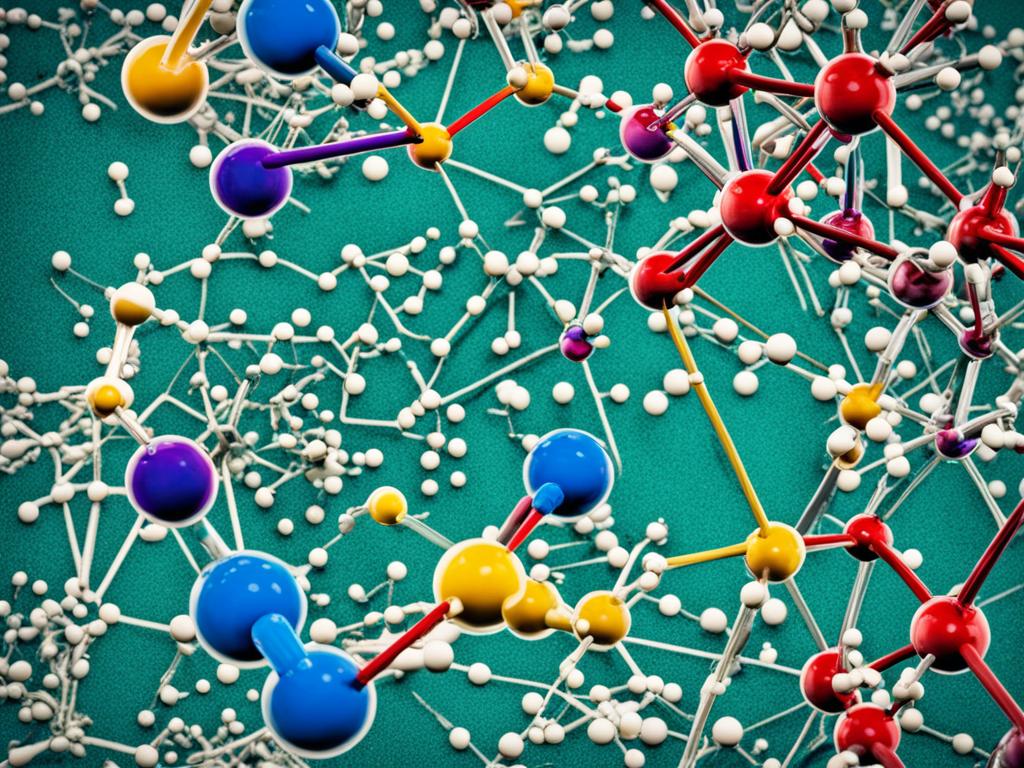
Conclusion
We’ve explored what organic chemistry is, its types, examples, and key principles. This field is vital and touches many areas of life and work. It helps us understand the world of organic compounds and how they react with each other.
It is crucial in fields like making medicines, creating new materials, and studying the environment. It’s also at the heart of research into sustainable chemistry and green chemistry. As our world changes, organic chemistry will play a big role in solving big problems and driving new discoveries.
Looking to the future, organic chemistry will focus more on making things better for the planet and finding new compounds. It will also tackle big issues like energy, the environment, and health. By pushing forward in these areas, experts and students can help shape the future of this exciting field.
FAQ
What is the definition and scope of organic chemistry?
Organic chemistry is all about studying carbon-based compounds. These can be found in living things or made in labs. It covers a wide range of substances like alkanes, alkenes, and aldehydes, among others.
What is the historical development of organic chemistry?
It started in the early 1800s when scientists noticed something special about carbon compounds. Over time, it grew from studying natural products to understanding how to make new compounds and their reactions.
What are the important applications of organic chemistry?
Organic chemistry is vital in many areas of life and industry. It helps make important compounds, develop new materials, and is key in fields like medicine and energy. It’s also crucial for making medicines and understanding how living things work.
What are the different types of organic compounds and their functional groups?
Organic compounds are grouped by their structure and functional groups. You’ll find alkanes, alkenes, and aldehydes, among others. Each type has its own set of properties and reacts differently because of its functional groups.
What are the basic principles of organic chemistry?
It follows basic rules about how carbon compounds work and react. These rules include how bonds form, the role of molecular structure, and the ways compounds change. Things like stereochemistry and reaction speed also matter a lot.
What are the key techniques used in organic chemistry?
Chemists use many methods to make, clean, and study organic compounds. They use things like synthetic methods, distillation, and NMR spectroscopy. These tools help them understand and work with these compounds.
How is organic chemistry related to biomolecules?
Organic chemistry is key to understanding biomolecules, which are vital in living things. It helps us grasp the structure and function of biomolecules like proteins and carbohydrates. This knowledge is crucial for understanding life processes.


